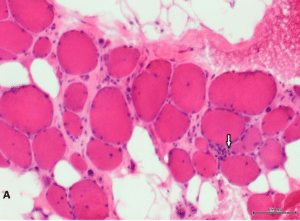
LINE-1 (long interspersed nuclear element) insertions cover almost 17% of the human genome, but they are notoriously difficult to resolve accurately with short-read sequencing technology, according to scientists in Portugal. That matters because intronic LINE-1 elements can cause disease. In a recent study, SMRT Sequencing made it possible to analyze the multi-kilobase region and find a mutation causing muscular dystrophy.
In “Exonization of an Intronic LINE-1 Element Causing Becker Muscular Dystrophy as a Novel Mutational Mechanism in Dystrophin Gene,” scientists from several institutes in Portugal report finding a LINE-1 insertion that disrupted an open reading frame in the dystrophin gene. Lead authors Ana Gonçalves and Jorge Oliveira, senior author Rosário Santos, and collaborators describe this work in the journal Genes.
The 50-year-old male patient suffered onset of Duchenne/Becker muscular dystrophy at age 13. Earlier attempts to identify the causative mutation — including multiplex-ligation probe amplification and genomic sequencing — had failed. The scientists used several technologies for this case, deploying SMRT Sequencing to genotype the LINE-1 element that was detected as an interruption in an open reading frame in the dystrophin gene. “An aberrant transcript was identified, containing a 103-nucleotide insertion between exons 51 and 52, with no similarity with the DMD gene,” the authors report. “This corresponded to the partial exonization of a long interspersed nuclear element.” SMRT Sequencing analysis confirmed that a full LINE-1 sequence was present, and perfectly matched an element located in chromosome 2 that might have been its source. Based on the discovery, the patient’s children were also analyzed and his daughter was found to be a carrier of the same mutation.
LINE-1 insertions within a gene are believed to be rare, with just 30 events reported in the literature, the scientists note. Most of those are found in exonic regions. Intronic LINE-1 insertions have been determined to cause disease in three cases, featuring chronic granulomatous disease, familial retinoblastoma, and Chanarin-Dorfman syndrome. It is possible that the small number of events reported is a result of technology limitations: “In the case of intronic LINE-1 insertions, detection may be hampered by the intron’s length and the fact that it mainly affects transcriptional events,” the scientists write.
“To our knowledge, this is the first report of a deep-intronic insertion of a LINE-1 element in the DMD gene shown to cause disease,” the scientists conclude. “Besides its scientific relevance … this finding also reinforces the need to develop comprehensive approaches to identify LINE-1 insertion profiles in the human genome.”
May 16, 2018 | Human genetics research